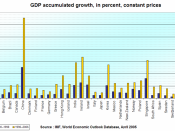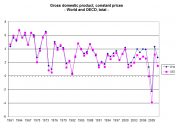Economy is defined as the management of the resources of a country with a view to its productivity. Belgium has a well-developed free market economy, based on both industrial and service sectors. It is heavily dependent on international trade and most of its economic sectors are geared toward exporting products. It belongs to the Organization for Economic Cooperation and Development (OECD), a group of leading industrialized democracies. With a geographic area about equal to that of Maryland, and a population of 10.4 million, Belgian per capita GDP ranks highest among the world. In 2006, the per capita income (PPP) was $31,800. The federal government has managed to present balanced budgets in recent years, but public debt remains high, at 94% at the end of 2005. GDP growth in 2006 was predicted to be 2.5%. The nation's exports are equivalent to almost two-thirds of its Gross National Product, or GNP. On a per capita basis, Belgium exports twice as much as Germany and five times as much as Japan.
The nation ranked number eleven among the world's top exporters in 1999. In spite of its small size, Belgium's economy has consistently placed among the top twenty economies of the world and remains strong. The country's exports have given it an account surplus that is the sixth largest among the highly developed economies of the world.
For most of its history, Belgium's economy was based on the nation's manufacturing capabilities. The country was the first in continental Europe to undergo the Industrial Revolution, and through the 19th century it was a major steel producer. Large coal deposits helped fuel the industrialization. At the same time, agriculture began to decline. This decline was even more pronounced after World War II, and by 2000, agriculture only accounted for a small percentage of the economy.


